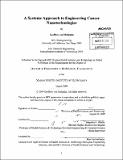A systems approach to engineering cancer nanotechnologies
Author(s)
Von Maltzahn, Geoffrey
DownloadFull printable version (31.18Mb)
Other Contributors
Harvard University--MIT Division of Health Sciences and Technology.
Advisor
Sangeeta N. Bhatia.
Terms of use
Metadata
Show full item recordAbstract
therapy. Over the past three decades, advances in nanomaterial synthesis have produced impressive nanostructures with unique electromagnetic and therapeutic properties. These represent a powerful toolkit of building blocks through which multi-component nanosystems could be constructed. Yet, while biological systems produce higher-order functions through coordinated interactions between multiple nanoscale components, biomedical nanotechnologies to date have largely lacked systems-scale complexity. Considering that typical in vivo doses of diagnostic or therapeutic nanoparticles exceed I trillion nanoparticles, there is considerable opportunity to construct multi-component, interactive nanoparticle systems that perform sophisticated new functions in vivo. This thesis takes a systems approach to engineering cancer nanotechnologies, where interactions between multiple nanoparticle populations are designed to generate emergent system properties for enhancing the sensing and targeting of cancer cells. In the first section of this thesis, direct nanoparticle interactions are engineered to produce emergent properties for cancer sensing. Three classes of magnetic particles are developed that respectively enable: MRI detection of single cancer-associated proteases, performance of logical AND/OR operations using two cancer-associated proteases, and reversible sensing of antagonistic kinase/phosphatase enzyme pairs. (cont.) In the second section of this thesis, indirect mechanisms of nanoparticle interaction-where nanoparticles communicate at a distance via intermediates-are engineered to amplify nanoparticle targeting to regions of tumor invasion in vivo. Two nanosystems are synthesized wherein intravenously administered nanoparticles that have successfully targeted tumors broadcast the tumor's location to other nanoparticles in circulation to recruit their amplified local accumulation. In mice, one of these systems intravenously delivers >40-fold higher drug doses to tumors than non-communicating controls, leading to durable repression of tumor growth and significantly improved host survival. Together, these systems highlight the potential for interactive nanoparticle systems to perform highly complex functions in vivo. In contrast to the current strategy of injecting large populations of nanoparticles that carry out identical, often competitive functions in vivo, this work promotes a paradigm of 'systems nanotechnology,' directed toward the construction of nanoparticle systems that produce emergent behaviors for enhancing in vivo diagnostics, regenerative medicines, and therapeutics.
Description
Thesis (Ph. D.)--Harvard-MIT Division of Health Sciences and Technology, February 2010. Vita. Cataloged from PDF version of thesis. Includes bibliographical references (p. 203-210).
Date issued
2010Department
Harvard University--MIT Division of Health Sciences and TechnologyPublisher
Massachusetts Institute of Technology
Keywords
Harvard University--MIT Division of Health Sciences and Technology.